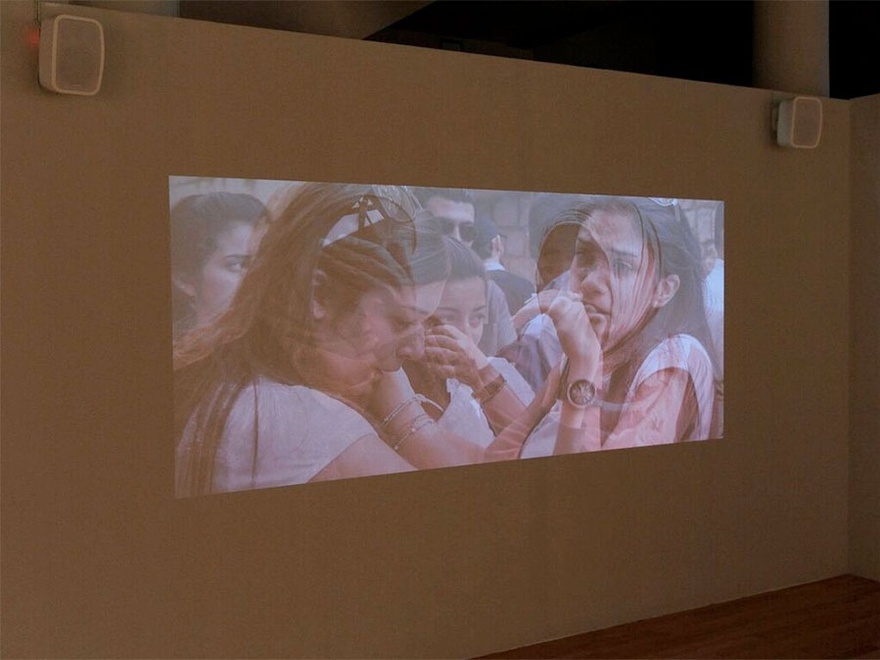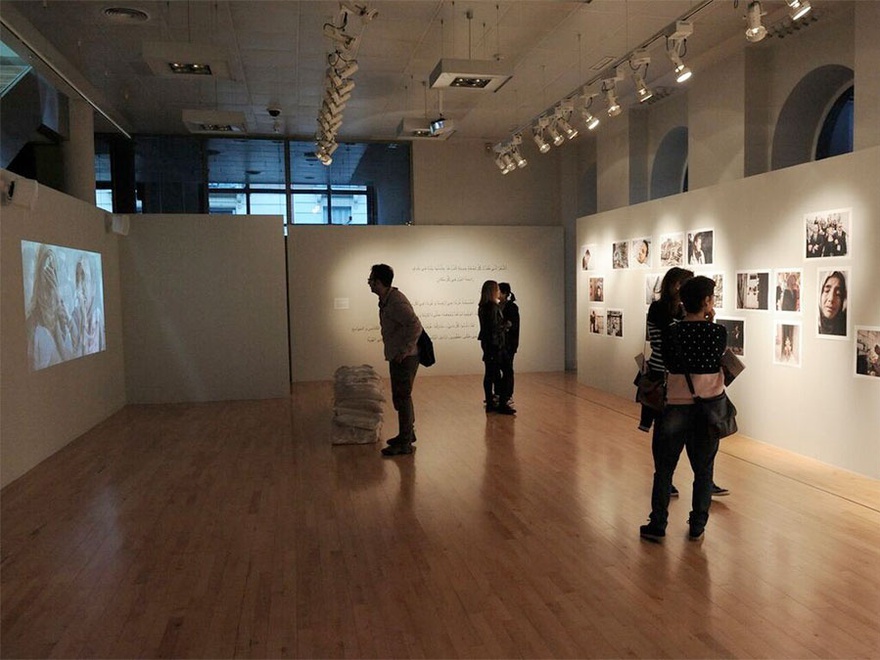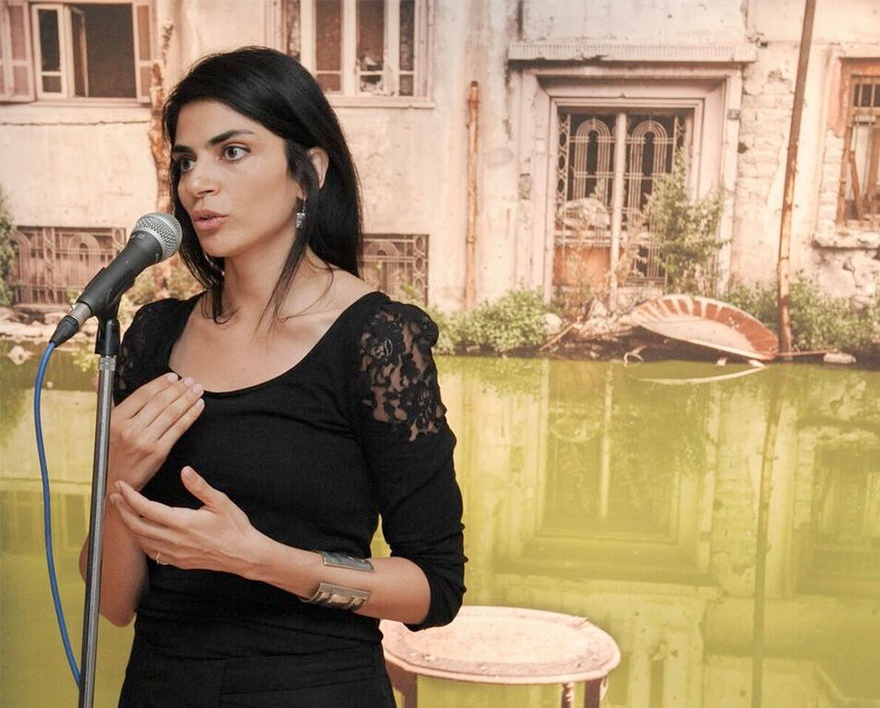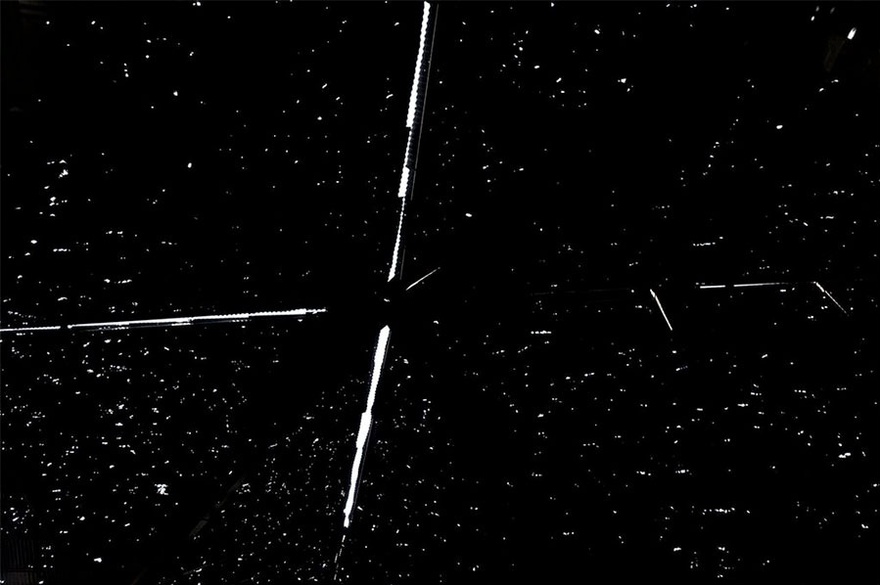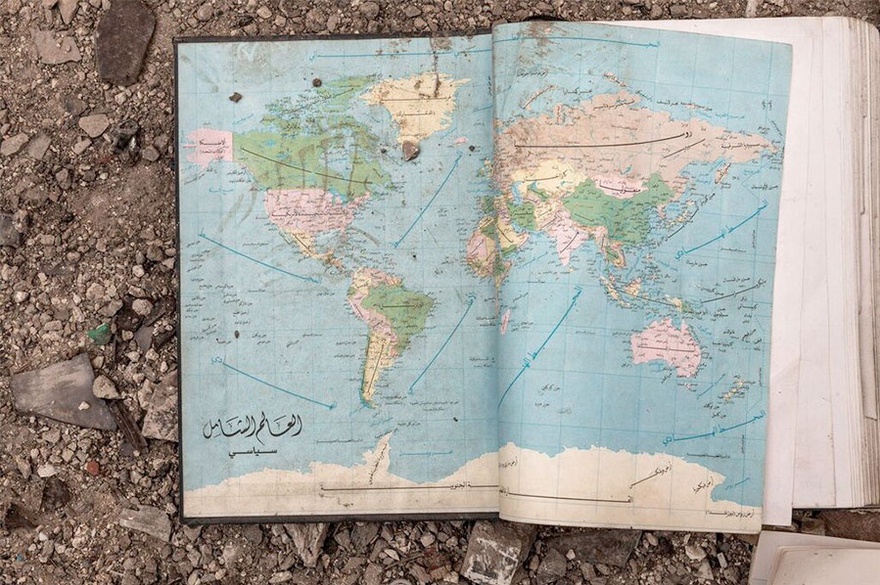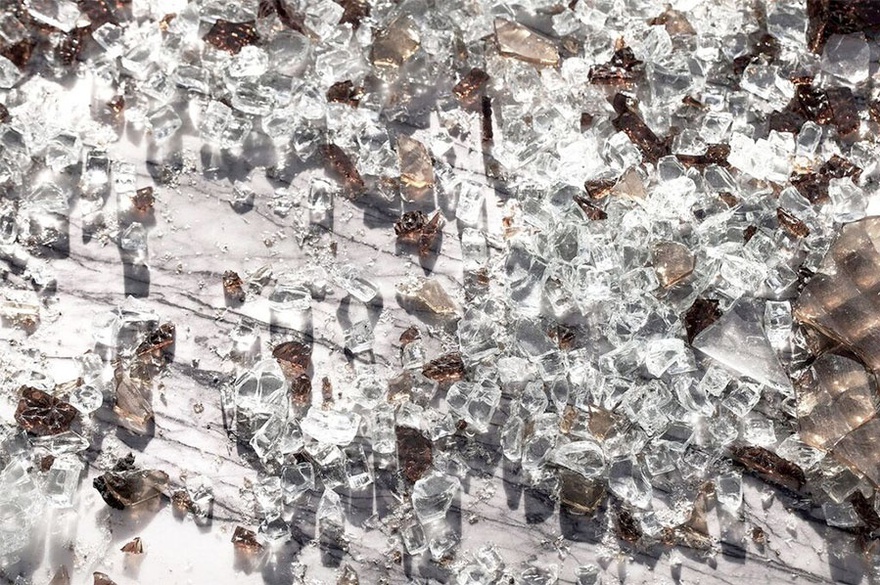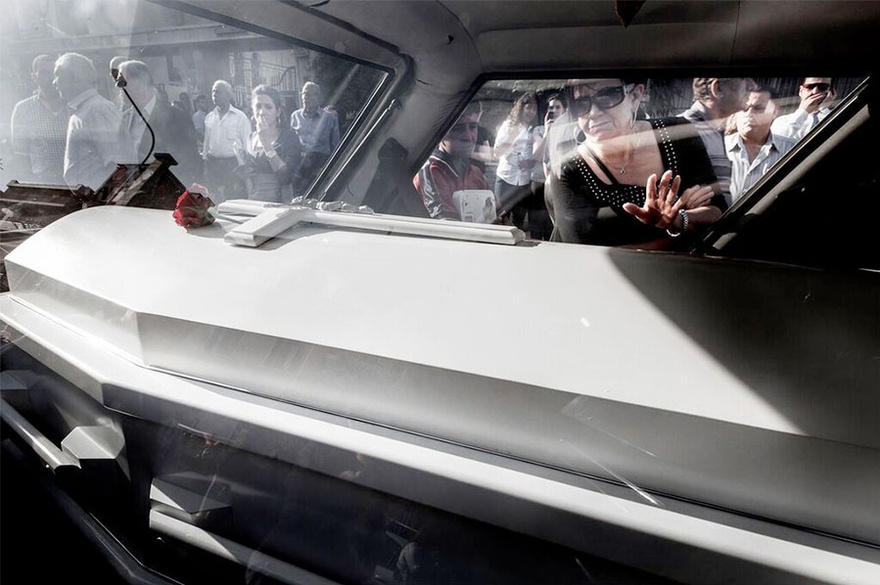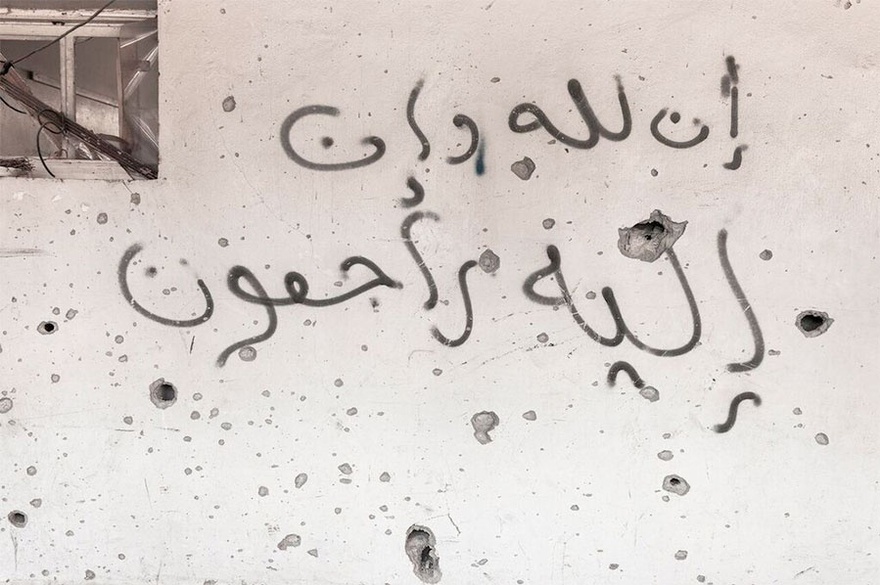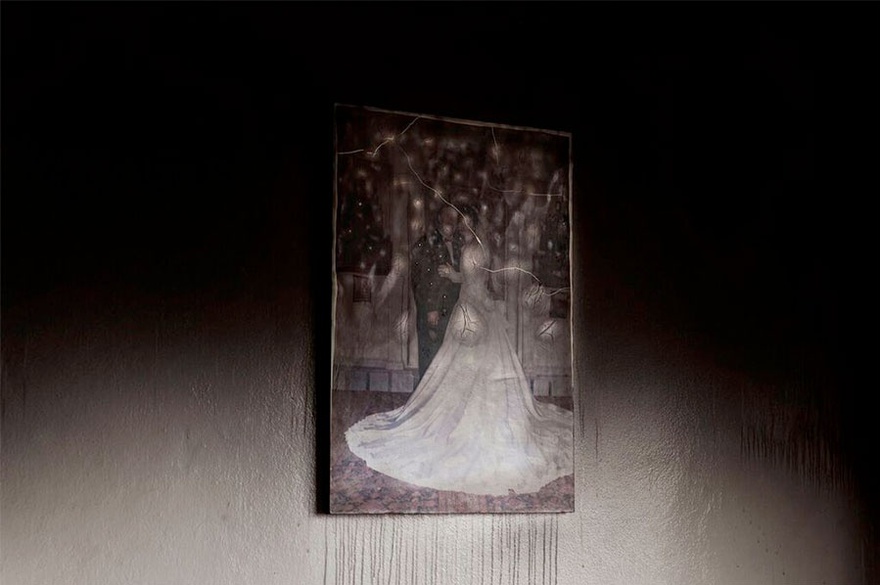Interviews
Picturing the Homeland
Carole Alfarah in conversation with María Gómez López
Born in Damascus, Carole Alfarah left Syria in 2012 to settle in Spain. Since then, Alfarah has returned several times to her homeland to document the everyday life of her surviving compatriots as a way of giving voice to those who are unable to move beyond the daily realities of conflict and political upheaval.
Currently based in Madrid, Alfarah held her first solo show, Wa Habibi, named after a song by Lebanese singer Fairuz, at Casa Arabe, an institution that aims to serve as meeting point between Spain and the Arab world. Divided in four parts, the show aims to bring audiences closer to Syria's layered histories through photography, video, sound, and installation that portray the country's streets, houses and inhabitants from a very intimate perspective; that of a person who recognizes that behind ruins and rubbles lies a decaying, beloved homeland.
Using the exhibition as point of departure, in the following discussion Alfarah speaks of her personal approach to conflict, the role of photography today, the importance of storytelling in her work, the working procedures she follows, and what Syria means to her.
Maria Gomez: Your exhibition Wa Habibi is the first time your work has been displayed in public in a solo show. How did the project begin?
Carole Alfarah: The story behind this project is a long one. Its origins can be traced back to 2011, when Syria started to change. At that moment, I was working for Syria Today Magazine – which has stopped running and its team dispersed – and an American photo agency named Polaris. I combined these jobs with my personal projects and freelance collaborations.
2011 was a moment of effervescence in my country. People started to move towards a change that brought freedom, public expression, and democracy. Some named it an uprising, others used the term 'Arab Spring' – revolution was another label that was used, which sounded poetic at the time but has since disappeared from discussion on Syria. Once arms started to be used, it became a war, a civil war, a holy war, an international conflict. The name is not important to me because any term seems less savage than what is happening in my homeland today.
In January 2012, the first suicide attack in Damascus occurred. The scene was awful; charred bodies, limbs, blood on the ground. I couldn't document the brutality the explosion left behind; I only took some general pictures and I photographed a spot of human blood on the ground. I understood that day that my Syria would never be the same. In March 2012, a huge car bomb targeted our neighborhood and from that day, I started documenting the scene after the explosions in Damascus. Now I talk about it as a project but then, I was just instinctually documenting what was happening around me. These works depicting target places and survivors would later inform the series After the Bombing, some of them included in Wa Habibi exhibition.
In December 2012, I was forced to leave Syria. However – and up until last year – I have returned several times, in part because I needed the world to know about people living in the shadow of Syria's war, those trapped in the country who hadn't chosen one side or another; who had not chosen war. When I left, I realized that many of those who had stayed in Syria were voiceless. I decided to use my camera to tell their story. I used to visit different families so as to get to know their situation and portray them in their context. I don't know what happened to most of them, but my images are my memories of these encounters and the moments we spent together.
I wanted to give these people a space, so I went to Casa Arabe to talk about the possibility of publishing a book of my work and as a result we ended up organizing the exhibition. At first, I was reticent to have my works displayed, as I was afraid that people would just see the images and leave. Rather, our intention was to have people visit the exhibition and leave carrying part of my own experience of what is happening in my homeland. The curator, Maria Santoyo, achieved this with the display, by combining images of abandoned cityscapes, unframed portraits of local inhabitants in their houses, my personal memories or even an interactive installation from which visitors can take a postcard. I am very grateful to her and I would like to mention that all this work was voluntary and nonprofit.
MG: What lies behind the title of the exhibition, Wa Habibi?
CA: The original name of the project was actually My Beloved Broken Home, but we chose Wa Habibi because it's shorter and we thought audiences in Spain would be more familiar with its meaning: 'oh mi amor' ('oh, my love'). In addition, Wa Habibi is a song by the Lebanese singer Fairuz, who is admired throughout the Arab-speaking world; yet this particular song, about Christ's crucifixion – widely listened to by the Christian community in the Middle East on Good Friday – could stand as a metaphor for Syria today, as the lyrics are a mourning for Christ's state and suffering at the end of his life.
MG: You have mentioned the need to give voice to those who have been forgotten, was what led you to start your career as a photographer. As such, could you explain how you understand the politics and role of photography today, especially regarding image production surrounding the conflict in Syria?
CA: I am not an art activist; I would like to clarify this. I believe in people, but not in politics. Photography is neither for me an artistic production in this context – it's my way of carrying a message, of giving voice to my people. However, I am one of the voiceless too, as we Syrians lack local press outlets and international newspapers follow a policy in which images of survivors' everyday life are not the focus.
I am totally against the spectacle of war, especially if my action while taking an image might hurt someone. I'm doing my best to combine my work with personal and professional ethics, even if I lose the opportunity of capturing a powerful image of war. I believe it's very necessary to show those who are living and surviving the war in Syria, not only images of those who are making it.
Since the Syrian conflict started, we have been surrounded by a great amount of visual materials that show tanks, warplanes, weapons, armed groups or dead people surrounded with other armed persons. I chose not to show or talk about those armed fighters, nor highlight their images in my exhibition or book because these people already have power and a voice; they don't need anyone to talk about them. Photography should raise awareness about the everyday life conditions of civilians. I must proudly say I am not the only one thinking this way. The role of photography today in terms of the Syrian conflict is, for me, a communicative and documentary tool that should be used with the greatest caution and respect.
MG: What position does this exhibition take regarding contemporary art production based on Syria? How should the audience engage with images and representations of the conflict?
CA: This exhibition should not be viewed as a pleasurable activity. I conceive of it as an interactive space for communication with audiences. This is an attempt at capturing a journey through the everyday life of Syria in its current circumstances. The idea of the exhibition is to bring my people closer, to materialize their quotidian life in war so audiences can grasp the gravity of the problem and the dramatic human consequences of the conflict.
MG: The exhibition is divided in two parts. The first shows large-scale images of distorted and empty urban landscapes, while the second is a collection of small scale unframed portraits of local inhabitants in their houses. How are the two of them connected? What is the proposal behind this display?
CA: Although broadly speaking we could differentiate two parts, I would rather say there are four. The exhibition starts with the images of surreal landscapes in the city as a consequence of war, most of them taken between 2012 and 2015. You have to look carefully to recognize what is represented. These distorted urban landscapes are also a reflection of the incomprehensible situations the war brings; the disorientation, the loss, the metamorphosis of the familiar and known space.
Secondly, there is an installation (no title) specifically designed for this exhibition, composed of three superimposed hanging textiles with the same photograph of the destroyed and empty city of Homs (the place is not identified in the exhibition) printed on each of them. The images are unsaturated, presenting a pale Syria, without colours. On the floor, there are several postcards with photographs of the inhabitants' personal belongings, which have been abandoned in the rubble; diaries, family portraits, magazines. This is the representation of the destruction of both the urban space and the normality of everyday life.
Finally, in the first gallery space, fragments from my diaries are written on the wall, which connects with the second room, where another series of selected texts of my memories can be read and listened to as part of an installation where a video and some photographs are projected. These are my personal reflections; I wanted to share them as I also feel part of this tragedy.
The last part of the exhibition is titled Look at Me and is composed of a series of photos of Syrians in their houses, some of them under construction and shared with other families. These pictures are left unframed because we thought this was a way of reducing the expositive character of the image, and to emphasize the presence of the portrayed individuals and the fact that they are not models, but real people.
On the last wall, there is a list of statistics, the numbers of the conflict. This is what usually appears firstly – or even exclusively – in the news. We wanted to avoid the frivolity of numbers. Instead, our aim was for visitors to engage with the stories and personal consequences of conflict on individuals and communities and then to translate that into numbers, so as to become aware of what is behind the digits. Closing the exhibition, we included a book with the displayed images and some extra photographs.
MG: On the already mentioned three hanging superimposed textiles installation – the pictures of the abandoned objects you found in the streets, from magazines to family pictures, which you place on the floor, represent pieces of a truncated everyday life. These confront the visitor with a violent exposure of intimacy, which creates a sense of proximity to the real, human impact of conflict. Could you expand on this?
CA: As I mentioned, this installation embodies the physical destruction of war but also the emotional dimension of a destroyed city, evidenced in the surreal transformation of a known space. It is also a way of conveying the unrecognizable aspect of your city, the disorientation, as well as the painful loss. For me, it was very impressive to find people's intimacy exposed in the street. It represented how their life is fragmented, undermined and completely ruined in war. I took pictures as a way of keeping the memories of these people alive.
MG: The installation is actually an interactive one, as visitors are invited to take a postcard before leaving. What is the intention behind this gesture?
CA: This is an explicit way of inviting people to interact, to connect more intimately with what is happening in Syria. I also wanted the audience to take home part of my experience and my people's experience, in a way that would keep the memory of those affected alive and as a reminder to the visitors that Syria is still under siege.
MG: On the back of these postcards, there is a poem by the Syrian writer Nizar Qabbani titled Balqis – named on behalf of her second wife, Balqis Al-Rawi, killed in an explosion at the Iraqi Embassy at Beirut in 1981 during the Lebanese Civil War. The selected fragment speaks of the presence of death everywhere, and, beside it, there is a stamp from the Syrian Arab Republic with an image of Zenobia, the 3rd century AD Queen of Palmyra. Coincidentally, it is also the name of one of the Italo Calvino's Invisible Cities. Why did you choose this image? What does it represent?
CA: As a woman and for others in Syria who have grown up with Zenobia's story, we are proud to have had her as a queen. There are various stories about her death, but my favorite is the one in which she decides to commit suicide so that nobody else can kill her. This represents for me pride, dignity and independence. And so for me, Zenobia is another metaphor for Syria – a beautiful, strong and powerful country which is now being reduced to destruction and nothingness. In response, I wanted to keep this dignified image of my homeland alive.
MG: This desire for dignity correlates to the intimate, subjective approach of your photography, which moves away from the usual objective and documentarist approach so prevalent in this era of globalized new media. Is this an attempt to raise awareness of what is happening on the other side of the Mediterranean in a moment of image overexposure?
CA: During the conflicts that devastated Syria's neighbouring countries, a lot of refugees came to our homeland. Despite our daily coexistence with them and the proximity of war, we watched the news and thought about their conflict as a distant problem. And suddenly, Syria became the battlefield. It was only then that we understood the effects of violence. In other places that are not under the effects of conflict is the same; it's very difficult to understand what war is unless, unfortunately, you live it. There is no feeling, article or even image or testimony; nothing, nothing at all in history that can describe exactly what war is.
By showing weapons or tanks, you don't connect with the 'other'; you only understand the 'other' when you see yourself in him. The best way of reaching people is by establishing personal bonds between you and them. And the intention guiding my work is to bring my people's history closer, and to invite the audience to communicate with them.
Regarding the medium, perhaps I find photography and the moving image to be the most immediate and universal way of establishing bonds. Of course, my personal approach comes through the images, given I am the one behind the camera.
MG: There are a lot of underlying stories in the exhibition. In your guided visit, you outlined the importance of gestures to understand them. How are these stories interwoven and what role does gesture play?
CA: The untold individual stories unveiled here, are the fabric of contemporary Syrian history. The last part of the exhibition, Look at Me is full of gestures and glances. Some individuals are looking down, others up, few of them are crying, some have closed their eyes. There is this little girl who looks at me through the mirror, unaware of being portrayed; in another, a woman smiling in the window. There are some scarce smiles, the little boy who covers his face as the women in his family did before me, a stranger, or the man who hides his face to cry.
We organized these images in a way that their eyes and motions would be the linking thread between them, so as the audience could follow their stories by going from eye to eye, from hand to smile, until they found their own gaze trapped in the story, until they could see themselves as one of them.
MG: Are the pictures, especially those with people, planned beforehand or are they spontaneous?
CA: They are planned. We organized the visits, in some cases as part of NGOs assignments, and I talked to the families before taking any picture. Almost all of them are photographed during the conversation and always with their permission. I spent time with people, and when I became one of them, then I took my pictures.
Each photographer has his way of working, but I believe in the importance of setting a limit and respecting people's life and sadness, and not to use it to make a photograph. On the contrary, we should let this photograph be their voice and message.
MG: In his Poetics of Space, Gaston Bachelard quoted Noel Arnaud, who said 'I am the space where I am', referring to how we come to embody and constitute the space we inhabit. It seems you frequently use places to talk about people. How does your choice of people and places in this exhibition reveal your personal approach to conflict and how does the space of this exhibition speak to and of its inhabitants?
CA: The space for me is related to time; you need time to make a place yours and once the space is appropriated, it is very hard to be separated from it. In war, this happens very frequently and very quickly.
We decided to open the exhibition with the urban landscapes followed by the Look At Me portraits inside the houses so as visitors would connect with people through the deteriorated (un)inhabited space. I also wanted to transmit this trauma of migration and displacement through the abandoned or humble places. For me no place could be understood or defined without its inhabitants. All these empty places still have the traces of many lives. It is hurtful to see the deserted cities because you somehow know they were once full of life.
MG: You mentioned in a previous conversation that you use a 35-50 millimeter lens, which captures the space the individuals in your photographs inhabit, which, in turn, leads to the permanent sense of immediacy that resonates in all your works. Is this intended?
CA: It's not only that I wanted to create an environment or to be inside the scene, it is that it happens to be the place I too inhabit: I am part of it, I belong there and as such, I was able to capture the intimacy. There resides the proximity and immediacy of my work, because it was as a way of retaining – through my camera – my lived experience at a given moment.
MG: Of course the image runs the risk of omitting context and becoming spectacle. Yet in your work, through the details you choose to photograph there is a manifest interest in capturing the smells or sounds of the places you portray. In fact, you mentioned their importance in this exhibition, but especially, and paradoxically, you talked about the presence of silence in your work. I wondered if you could say something on this latent muteness.
CA: It is crazy to say there's silence in war but, in fact, it has a great presence. When I last visited Homs the silence was overwhelming, almost unbearable. The city was empty and destroyed. We were a group of three and I used to enter the houses alone; everything was burnt and black and the silence contained all the tragedies Homs had witnessed. Even though the city was in a truce, this silence was not that of peace. It was silence of oblivion, of threat and death. However, silence for me in Syria is not only linked to place, but also inherent to my people. They have not chosen this war, they don't have a political side and thus, speaking is dangerous. They are afraid and voiceless. In this sense, silence is somehow related to politics, and to a position of neutrality.
One man I visited at the hospital who had survived an explosion told me that during the first days after his injuries, he couldn't neither close his eyes, nor say a word. In another visit I made to a family, one of the women had lost her partner. We met at her house, which she shared with other internally displaced persons, some of whom were present during the conversation. Even though she had previously told me she was ready to talk, after my first question, a thick silence filled the room and nobody dared to say anything for a while. Even when I left Syria, I wasn't able to talk about war, give interviews, or even say where I was from.
All these silences are conveyed in the exhibition; in fact, the only sound you hear is that of my memories being narrated as part of the video installation.
MG: Thinking about how silence relates to absence, and the emptiness of the urban landscapes you portray, a book by the Palestinian poet Mahmud Darwish titled In the Presence of Absence (2006) comes to mind. Is the overwhelming presence of absence captured in your work a way to avoid producing imagery that contributes to the spectacle of war?
CA: This is the first war I have witnessed and I hope the last one. It's sad realizing that while we are doing this interview, the war is ongoing. I feel I'm divided; a part of me is here, but the other part of me stayed there. This is the dichotomy of presence-absence that I am experiencing. In war there are a lot of absences. The absence of peace, of people, of life, of normality; at the same time, all of them are painfully present, rendered explicit in the deafening and invading silence. War is a handful of absences and silence.
MG: I have noticed that no urban image has a name or identifying element of the city it represents, or the time it was taken. Why is this? Is it an attempt of turning Syria into a universal and timeless city?
CA: This is because the cities I capture represent all Syria, all its neighborhoods, streets and houses. What is happening is dividing Syrian population into ideological categories, pro or against the regime, and the country is geographically split into territories occupied by the rebels, Turkey, Kurds or the Islamic State. I didn't want to contribute to this division; I wanted to preserve Syria as a whole.
MG: It is interesting how you engage with the politics of narration and visual storytelling as a way of keeping individual and collective memory alive and critical. Coming from the land of the hakawatis, or storytellers, how do you tell a story with your camera? What role does memory play in your work and how is it rendered explicit in this exhibition?
CA: I turned into a storyteller in 2009, perhaps unconsciously. I have a curiosity towards people and their stories and so I can spend hours talking with strangers. I have no boundaries with people.
I started my career as fashion photographer's assistant in Belgium, but I soon discovered it wasn't my path. I went back to Syria to work as photographer but it was hard as there was little support. In 2007, I undertook a World Press Photo training course during which I learnt a lot about documentary, photojournalism and the 'out of the studio' photography. When I finished this training, I started working on a low-budget project about a displaced poor Syrian family who lived in a factory's backyard. After this, I started to investigate the stories behind child labour.
Between 2009 and 2012, I followed and documented the lives of Sabah and Nader, two siblings living on the streets of Damascus. I wanted to create an extended project, to document their life until they became old, and we frequently met. But when the war broke out, I lost touch with them and my project was interrupted. This was my first long-term documentary story.
I progressively began realizing photography's potential for narrating the story of marginalized people in Syrian society; even before war, I worked with people on the periphery of social and political life. For example, one of my projects was focused on uneducated women who led micro-financed initiatives from home in order to provide for their children; and another, focused on punk teenagers in Damascus.
MG: Syria is today mediated by images of trauma and war, but as you have said, this is not the full picture of what Syria is. This relates to the subjective, fragmentary and unstable character of documentary photography, that only shows a partial approach to the portrayed subject. Taking into account the personal idiosyncrasy of documentary photography and the need for unveiling the other Syria behind the conflict, is your work a space of encounter with the pre-war Syria? If so, what image would you take to define your homeland?
CA: This is a very complicated question; the answer will be very personal. Children born in war will not have the same image of Syria. I'm so lucky I have memories of Syria before the war, and in that regard I am blessed. It is complicated to convey in my images the pre-war Syria, but of course it is there.
I will explain my image of my homeland this way. Syria as I mentioned earlier is – like Zenobia – a very beautiful and strong woman. This beautiful woman I know is like a very close friend or even like my mother. All my memories are there, she keeps all my secrets, even those nobody know about, my concerns and aspirations, all my 'first times'. I wish you had met her. Even her walls talked if you listened closely. However, this beautiful Syria I know is sick and finds herself in a very complicated stage of being. Now she has lost everything; she is weak and losing her colour. She is not able to keep my secrets, to listen to my story anymore. Still, I don't want my Syria to die. I can't stand to see this beautiful person fading away. All I know is that she is not the woman I once met, and that she will never be the same.
This is Syria for me, a person I love so much. What lies behind the ruins is this intimate relationship, the blurring memory of this delicate wreck of secrets, intimacies and first times.
Carole Alfarah (b. Damascus, Syria, 1981) is an independent Documentary photographer and Multimedia Storyteller, currently based in Madrid. She studied at the Damascus Photography Club and Contrast Photography School (Brussels). She was a grantee participant in the World Press Photo training program in the MENA region (2009), the Foundry Photojournalism Workshop in Sarajevo (2013) and The NOOR Agency Masterclass in Istanbul (2014). She has received the UNICEF Prize of Arab Media Award for Children's Rights (2011), the Jury Prize for the One Shot International Photography Competition 'Femmes au Travail' (Marseille, France, 2013), Roberto Villagraz Scholarship (EFTI, Madrid 2015) and IWMF's Howard G. Buffett Fund for Women Journalists (2016). Her work has been exhibited at Casa Arabe, Angkor Photo Festival 2013 in Cambodia or the 6th Baltic Photo Biennale in Russia and published in the Wall Street Journal, Le Monde, Days Japan, Syria Today Magazine, Newsweek or The Guardian Among others.

